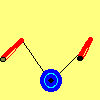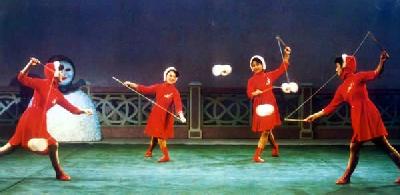 Diabolo spinning, also known as "bell spinning" or "kitespinning," is a traditional form of folkacrobaticsof the Han people all over the country, especially northern China. The diabolo refers to a kind of toy that hums when spun.
Diabolo spinning, also known as "bell spinning" or "kitespinning," is a traditional form of folkacrobaticsof the Han people all over the country, especially northern China. The diabolo refers to a kind of toy that hums when spun.
 History of Diabolo Spinning
History of Diabolo Spinning
Diabolo spinning has a long and enduring history in China. As early as theThree Kingdoms Period(220-280), Cao Zhi, a famous poet, wrote a poem entitled "Ode to the Diabolo," in which he depicted the skills and sounds involved in playing the diabolo. Liu Tong of theMing Dynasty(1368-1644) also related the techniques of making and playing diabolos in one of his articles. Historical records show that by theQing Dynasty(1644-1911), diabolo spinning had become a favorite acrobatics program. During this period, performers added many new stunts and high-level skills to their act. During its development, the appearance of the diabolo had also changed and some performers even use teacups and small vases as substitutes. Duringthe Republic of China(1912-1949), theTianjinfolk artist Tian Shuangliang even used wine gourds to play the diabolo.
 Ways to Spin the Diabolo
Ways to Spin the Diabolo

Diabolos generally fall into two categories -- single and dual axes -- that are hollow, with four or five holes in each to produce sound. Attached to the axis is a cylindrical handle, which is very slender in the middle. The diabolo is first tied to a string attached to two small sticks at the end and then rolled on the ground. The sticks are held up by the players as the string is reeled around the diabolo axis. The diabolo is rolled again and again as the sticks are manipulated, making the string vibrate. This way, the diabolo spins as it is manipulated from side to side; it can be flung into the air and retrieved again while spinning. When the diabolo spins fast enough, it produces a humming sound. It can resemble the sound of a cicada or that of a pigeon depending on the type of diabolo. For this reason, diabolos were also called "clap less bells" during the Ming Dynasty and "vibrating bells" in southern China. Diabolo players say that producing and maintaining the spinning motion and hum gives them a great "rush" of excitement.
 Diabolo Spinning and the Spring Festival
Diabolo Spinning and the Spring Festival

Although diabolos are small, it takes every muscle in the body to manipulate them. Since diabbolo spinning is a good form of exercise and can generate a lot of heat, it is a popular traditional pastime in northern China during cold winter days. During the Spring Festival, the sound of diabolos in Beijing is especially resonant. Sometimes, people compete with each another when playing diabolo to express their jubilation.
The sport is imbued with a strong national flavor. The performer gracefully spins the diabolo rapidly, twirling it around his or her body, throwing it up into the air or even passing it to another player. While spinning the diabolo, players often create interesting poses. China's national orchestral music, coupled with the humming sound of the diabolo, creates a warm and festive atmosphere.
Nowadays, diabolos can still be purchased at theNanjingConfuciusTempleduring the Spring Festival, where middle-aged and older people are seen spinning the diabolo and exchanging spinning techniques.
